Commercial and Corporation Law Assignment - University
VerifiedAdded on 2021/04/22
|10
|2711
|63
Homework Assignment
AI Summary
This assignment delves into the intricacies of commercial and corporation law, focusing on key aspects such as the duties of directors under the Corporations Act 2001 (Cth) in Australia, and the complexities surrounding their personal liability for corporate torts. It examines the legal principle of separate legal personality as established in Salomon v Salomon & Co Ltd, and explores the attribution of actions to a company, differentiating between primary and secondary liabilities. The assignment also addresses the criminal liability of corporate legal persons, referencing relevant sections of the Criminal Code and common law principles. It covers various criminal offences where companies can be held liable, including bribery, false accounting, and money laundering. The assignment discusses the attribution of fault and physical elements, the application of the identification test, and the benefit test in determining corporate criminal liability.
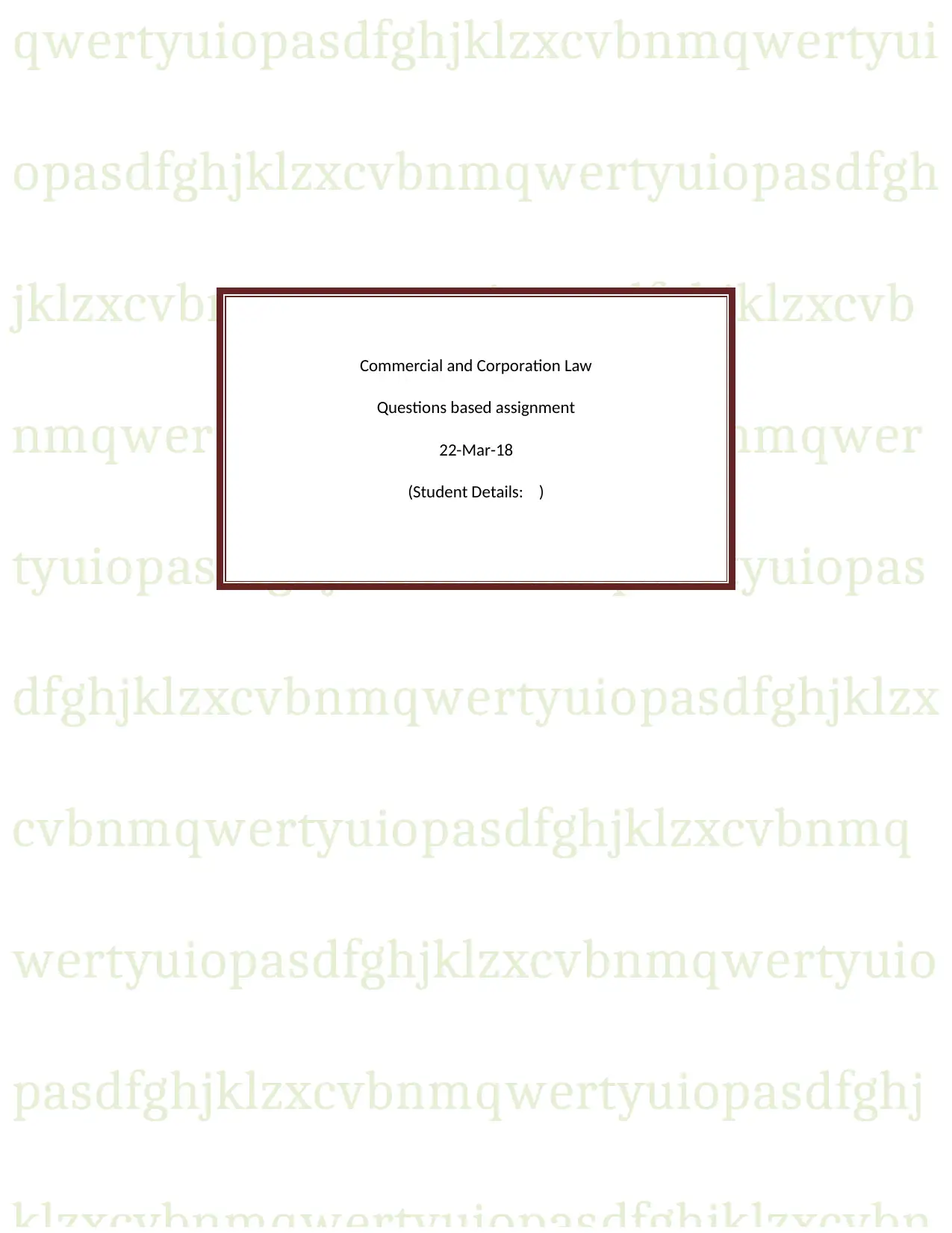
qwertyuiopasdfghjklzxcvbnmqwertyui
opasdfghjklzxcvbnmqwertyuiopasdfgh
jklzxcvbnmqwertyuiopasdfghjklzxcvb
nmqwertyuiopasdfghjklzxcvbnmqwer
tyuiopasdfghjklzxcvbnmqwertyuiopas
dfghjklzxcvbnmqwertyuiopasdfghjklzx
cvbnmqwertyuiopasdfghjklzxcvbnmq
wertyuiopasdfghjklzxcvbnmqwertyuio
pasdfghjklzxcvbnmqwertyuiopasdfghj
Commercial and Corporation Law
Questions based assignment
22-Mar-18
(Student Details: )
opasdfghjklzxcvbnmqwertyuiopasdfgh
jklzxcvbnmqwertyuiopasdfghjklzxcvb
nmqwertyuiopasdfghjklzxcvbnmqwer
tyuiopasdfghjklzxcvbnmqwertyuiopas
dfghjklzxcvbnmqwertyuiopasdfghjklzx
cvbnmqwertyuiopasdfghjklzxcvbnmq
wertyuiopasdfghjklzxcvbnmqwertyuio
pasdfghjklzxcvbnmqwertyuiopasdfghj
Commercial and Corporation Law
Questions based assignment
22-Mar-18
(Student Details: )
Paraphrase This Document
Need a fresh take? Get an instant paraphrase of this document with our AI Paraphraser
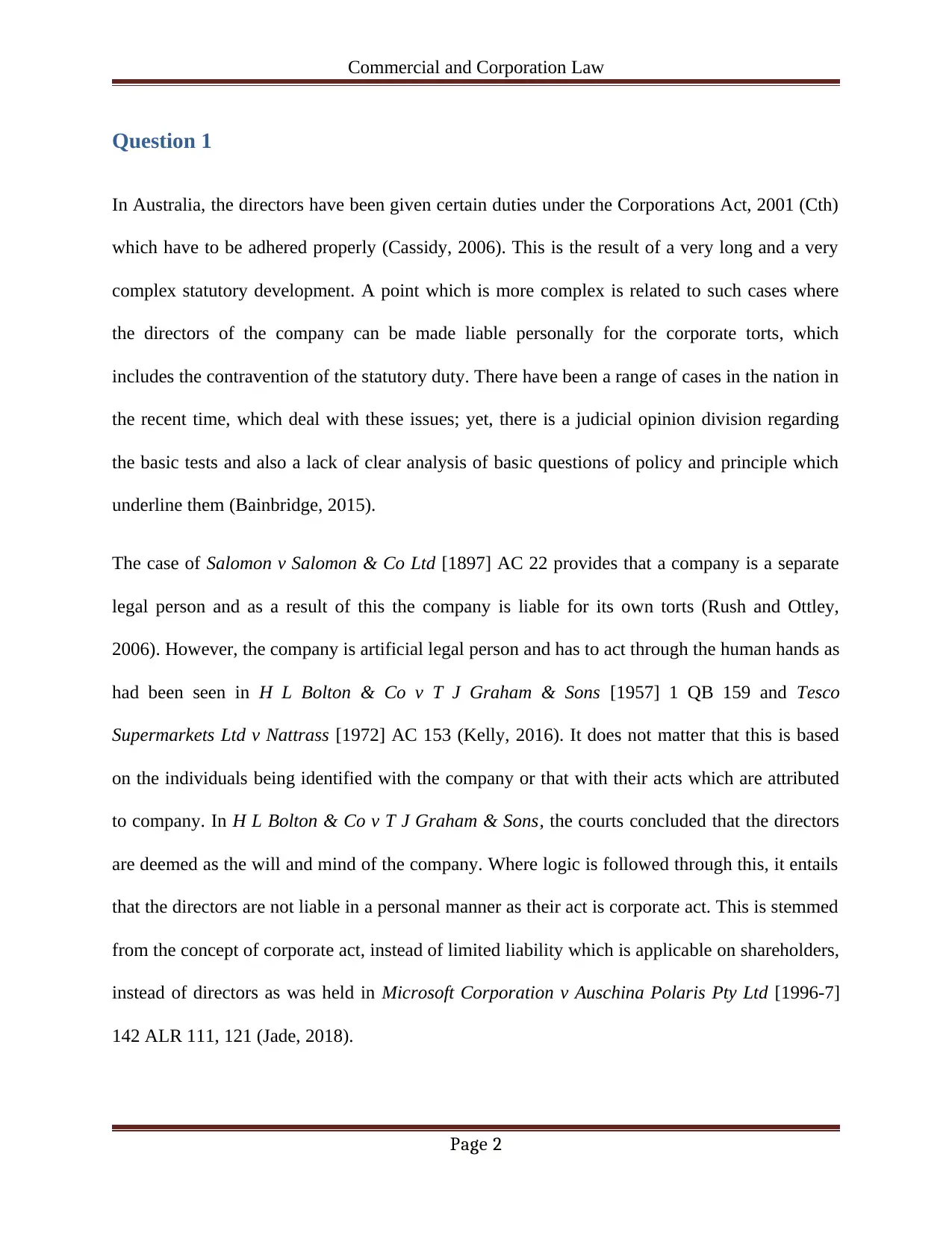
Commercial and Corporation Law
Question 1
In Australia, the directors have been given certain duties under the Corporations Act, 2001 (Cth)
which have to be adhered properly (Cassidy, 2006). This is the result of a very long and a very
complex statutory development. A point which is more complex is related to such cases where
the directors of the company can be made liable personally for the corporate torts, which
includes the contravention of the statutory duty. There have been a range of cases in the nation in
the recent time, which deal with these issues; yet, there is a judicial opinion division regarding
the basic tests and also a lack of clear analysis of basic questions of policy and principle which
underline them (Bainbridge, 2015).
The case of Salomon v Salomon & Co Ltd [1897] AC 22 provides that a company is a separate
legal person and as a result of this the company is liable for its own torts (Rush and Ottley,
2006). However, the company is artificial legal person and has to act through the human hands as
had been seen in H L Bolton & Co v T J Graham & Sons [1957] 1 QB 159 and Tesco
Supermarkets Ltd v Nattrass [1972] AC 153 (Kelly, 2016). It does not matter that this is based
on the individuals being identified with the company or that with their acts which are attributed
to company. In H L Bolton & Co v T J Graham & Sons, the courts concluded that the directors
are deemed as the will and mind of the company. Where logic is followed through this, it entails
that the directors are not liable in a personal manner as their act is corporate act. This is stemmed
from the concept of corporate act, instead of limited liability which is applicable on shareholders,
instead of directors as was held in Microsoft Corporation v Auschina Polaris Pty Ltd [1996-7]
142 ALR 111, 121 (Jade, 2018).
Page 2
Question 1
In Australia, the directors have been given certain duties under the Corporations Act, 2001 (Cth)
which have to be adhered properly (Cassidy, 2006). This is the result of a very long and a very
complex statutory development. A point which is more complex is related to such cases where
the directors of the company can be made liable personally for the corporate torts, which
includes the contravention of the statutory duty. There have been a range of cases in the nation in
the recent time, which deal with these issues; yet, there is a judicial opinion division regarding
the basic tests and also a lack of clear analysis of basic questions of policy and principle which
underline them (Bainbridge, 2015).
The case of Salomon v Salomon & Co Ltd [1897] AC 22 provides that a company is a separate
legal person and as a result of this the company is liable for its own torts (Rush and Ottley,
2006). However, the company is artificial legal person and has to act through the human hands as
had been seen in H L Bolton & Co v T J Graham & Sons [1957] 1 QB 159 and Tesco
Supermarkets Ltd v Nattrass [1972] AC 153 (Kelly, 2016). It does not matter that this is based
on the individuals being identified with the company or that with their acts which are attributed
to company. In H L Bolton & Co v T J Graham & Sons, the courts concluded that the directors
are deemed as the will and mind of the company. Where logic is followed through this, it entails
that the directors are not liable in a personal manner as their act is corporate act. This is stemmed
from the concept of corporate act, instead of limited liability which is applicable on shareholders,
instead of directors as was held in Microsoft Corporation v Auschina Polaris Pty Ltd [1996-7]
142 ALR 111, 121 (Jade, 2018).
Page 2
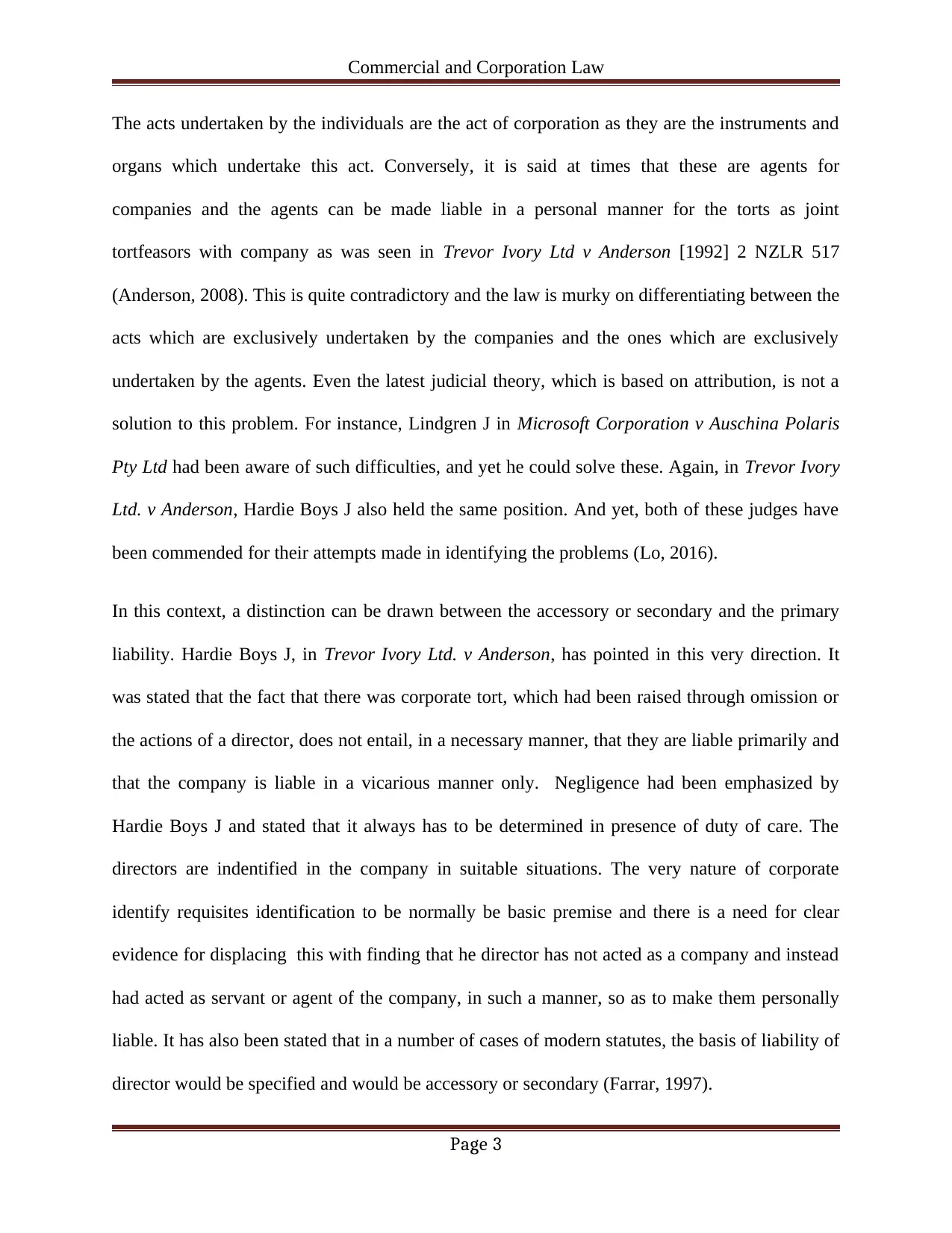
Commercial and Corporation Law
The acts undertaken by the individuals are the act of corporation as they are the instruments and
organs which undertake this act. Conversely, it is said at times that these are agents for
companies and the agents can be made liable in a personal manner for the torts as joint
tortfeasors with company as was seen in Trevor Ivory Ltd v Anderson [1992] 2 NZLR 517
(Anderson, 2008). This is quite contradictory and the law is murky on differentiating between the
acts which are exclusively undertaken by the companies and the ones which are exclusively
undertaken by the agents. Even the latest judicial theory, which is based on attribution, is not a
solution to this problem. For instance, Lindgren J in Microsoft Corporation v Auschina Polaris
Pty Ltd had been aware of such difficulties, and yet he could solve these. Again, in Trevor Ivory
Ltd. v Anderson, Hardie Boys J also held the same position. And yet, both of these judges have
been commended for their attempts made in identifying the problems (Lo, 2016).
In this context, a distinction can be drawn between the accessory or secondary and the primary
liability. Hardie Boys J, in Trevor Ivory Ltd. v Anderson, has pointed in this very direction. It
was stated that the fact that there was corporate tort, which had been raised through omission or
the actions of a director, does not entail, in a necessary manner, that they are liable primarily and
that the company is liable in a vicarious manner only. Negligence had been emphasized by
Hardie Boys J and stated that it always has to be determined in presence of duty of care. The
directors are indentified in the company in suitable situations. The very nature of corporate
identify requisites identification to be normally be basic premise and there is a need for clear
evidence for displacing this with finding that he director has not acted as a company and instead
had acted as servant or agent of the company, in such a manner, so as to make them personally
liable. It has also been stated that in a number of cases of modern statutes, the basis of liability of
director would be specified and would be accessory or secondary (Farrar, 1997).
Page 3
The acts undertaken by the individuals are the act of corporation as they are the instruments and
organs which undertake this act. Conversely, it is said at times that these are agents for
companies and the agents can be made liable in a personal manner for the torts as joint
tortfeasors with company as was seen in Trevor Ivory Ltd v Anderson [1992] 2 NZLR 517
(Anderson, 2008). This is quite contradictory and the law is murky on differentiating between the
acts which are exclusively undertaken by the companies and the ones which are exclusively
undertaken by the agents. Even the latest judicial theory, which is based on attribution, is not a
solution to this problem. For instance, Lindgren J in Microsoft Corporation v Auschina Polaris
Pty Ltd had been aware of such difficulties, and yet he could solve these. Again, in Trevor Ivory
Ltd. v Anderson, Hardie Boys J also held the same position. And yet, both of these judges have
been commended for their attempts made in identifying the problems (Lo, 2016).
In this context, a distinction can be drawn between the accessory or secondary and the primary
liability. Hardie Boys J, in Trevor Ivory Ltd. v Anderson, has pointed in this very direction. It
was stated that the fact that there was corporate tort, which had been raised through omission or
the actions of a director, does not entail, in a necessary manner, that they are liable primarily and
that the company is liable in a vicarious manner only. Negligence had been emphasized by
Hardie Boys J and stated that it always has to be determined in presence of duty of care. The
directors are indentified in the company in suitable situations. The very nature of corporate
identify requisites identification to be normally be basic premise and there is a need for clear
evidence for displacing this with finding that he director has not acted as a company and instead
had acted as servant or agent of the company, in such a manner, so as to make them personally
liable. It has also been stated that in a number of cases of modern statutes, the basis of liability of
director would be specified and would be accessory or secondary (Farrar, 1997).
Page 3
⊘ This is a preview!⊘
Do you want full access?
Subscribe today to unlock all pages.

Trusted by 1+ million students worldwide
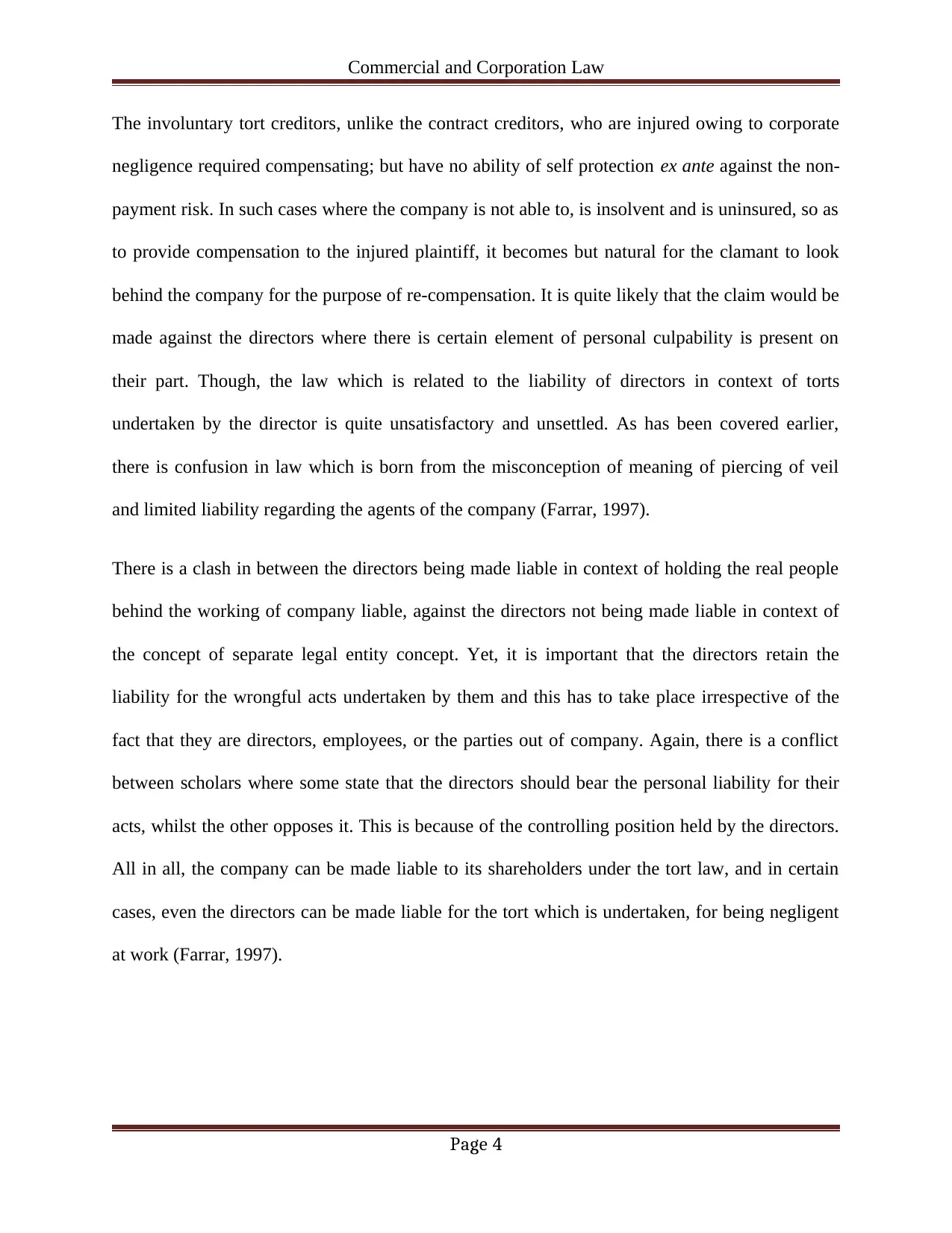
Commercial and Corporation Law
The involuntary tort creditors, unlike the contract creditors, who are injured owing to corporate
negligence required compensating; but have no ability of self protection ex ante against the non-
payment risk. In such cases where the company is not able to, is insolvent and is uninsured, so as
to provide compensation to the injured plaintiff, it becomes but natural for the clamant to look
behind the company for the purpose of re-compensation. It is quite likely that the claim would be
made against the directors where there is certain element of personal culpability is present on
their part. Though, the law which is related to the liability of directors in context of torts
undertaken by the director is quite unsatisfactory and unsettled. As has been covered earlier,
there is confusion in law which is born from the misconception of meaning of piercing of veil
and limited liability regarding the agents of the company (Farrar, 1997).
There is a clash in between the directors being made liable in context of holding the real people
behind the working of company liable, against the directors not being made liable in context of
the concept of separate legal entity concept. Yet, it is important that the directors retain the
liability for the wrongful acts undertaken by them and this has to take place irrespective of the
fact that they are directors, employees, or the parties out of company. Again, there is a conflict
between scholars where some state that the directors should bear the personal liability for their
acts, whilst the other opposes it. This is because of the controlling position held by the directors.
All in all, the company can be made liable to its shareholders under the tort law, and in certain
cases, even the directors can be made liable for the tort which is undertaken, for being negligent
at work (Farrar, 1997).
Page 4
The involuntary tort creditors, unlike the contract creditors, who are injured owing to corporate
negligence required compensating; but have no ability of self protection ex ante against the non-
payment risk. In such cases where the company is not able to, is insolvent and is uninsured, so as
to provide compensation to the injured plaintiff, it becomes but natural for the clamant to look
behind the company for the purpose of re-compensation. It is quite likely that the claim would be
made against the directors where there is certain element of personal culpability is present on
their part. Though, the law which is related to the liability of directors in context of torts
undertaken by the director is quite unsatisfactory and unsettled. As has been covered earlier,
there is confusion in law which is born from the misconception of meaning of piercing of veil
and limited liability regarding the agents of the company (Farrar, 1997).
There is a clash in between the directors being made liable in context of holding the real people
behind the working of company liable, against the directors not being made liable in context of
the concept of separate legal entity concept. Yet, it is important that the directors retain the
liability for the wrongful acts undertaken by them and this has to take place irrespective of the
fact that they are directors, employees, or the parties out of company. Again, there is a conflict
between scholars where some state that the directors should bear the personal liability for their
acts, whilst the other opposes it. This is because of the controlling position held by the directors.
All in all, the company can be made liable to its shareholders under the tort law, and in certain
cases, even the directors can be made liable for the tort which is undertaken, for being negligent
at work (Farrar, 1997).
Page 4
Paraphrase This Document
Need a fresh take? Get an instant paraphrase of this document with our AI Paraphraser
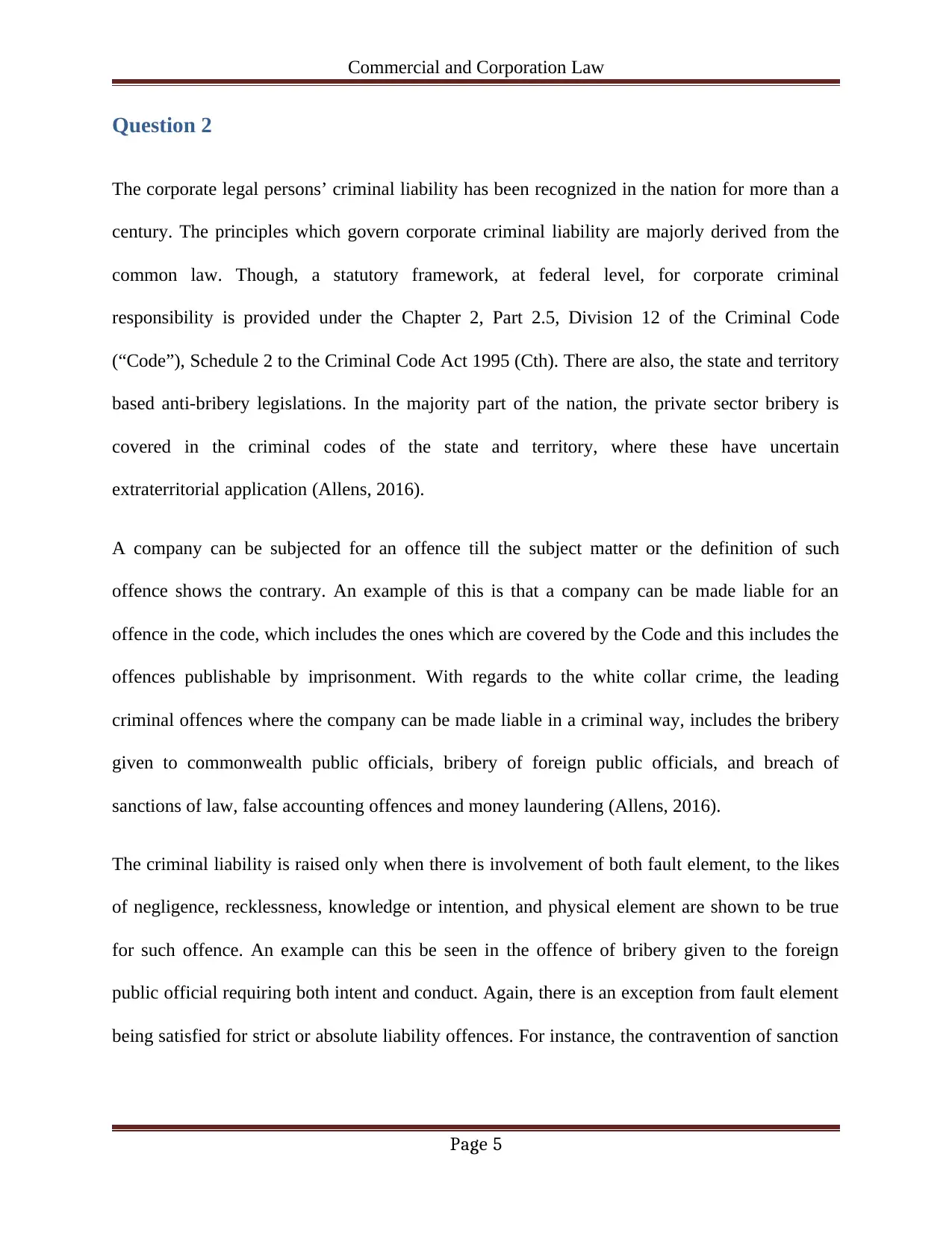
Commercial and Corporation Law
Question 2
The corporate legal persons’ criminal liability has been recognized in the nation for more than a
century. The principles which govern corporate criminal liability are majorly derived from the
common law. Though, a statutory framework, at federal level, for corporate criminal
responsibility is provided under the Chapter 2, Part 2.5, Division 12 of the Criminal Code
(“Code”), Schedule 2 to the Criminal Code Act 1995 (Cth). There are also, the state and territory
based anti-bribery legislations. In the majority part of the nation, the private sector bribery is
covered in the criminal codes of the state and territory, where these have uncertain
extraterritorial application (Allens, 2016).
A company can be subjected for an offence till the subject matter or the definition of such
offence shows the contrary. An example of this is that a company can be made liable for an
offence in the code, which includes the ones which are covered by the Code and this includes the
offences publishable by imprisonment. With regards to the white collar crime, the leading
criminal offences where the company can be made liable in a criminal way, includes the bribery
given to commonwealth public officials, bribery of foreign public officials, and breach of
sanctions of law, false accounting offences and money laundering (Allens, 2016).
The criminal liability is raised only when there is involvement of both fault element, to the likes
of negligence, recklessness, knowledge or intention, and physical element are shown to be true
for such offence. An example can this be seen in the offence of bribery given to the foreign
public official requiring both intent and conduct. Again, there is an exception from fault element
being satisfied for strict or absolute liability offences. For instance, the contravention of sanction
Page 5
Question 2
The corporate legal persons’ criminal liability has been recognized in the nation for more than a
century. The principles which govern corporate criminal liability are majorly derived from the
common law. Though, a statutory framework, at federal level, for corporate criminal
responsibility is provided under the Chapter 2, Part 2.5, Division 12 of the Criminal Code
(“Code”), Schedule 2 to the Criminal Code Act 1995 (Cth). There are also, the state and territory
based anti-bribery legislations. In the majority part of the nation, the private sector bribery is
covered in the criminal codes of the state and territory, where these have uncertain
extraterritorial application (Allens, 2016).
A company can be subjected for an offence till the subject matter or the definition of such
offence shows the contrary. An example of this is that a company can be made liable for an
offence in the code, which includes the ones which are covered by the Code and this includes the
offences publishable by imprisonment. With regards to the white collar crime, the leading
criminal offences where the company can be made liable in a criminal way, includes the bribery
given to commonwealth public officials, bribery of foreign public officials, and breach of
sanctions of law, false accounting offences and money laundering (Allens, 2016).
The criminal liability is raised only when there is involvement of both fault element, to the likes
of negligence, recklessness, knowledge or intention, and physical element are shown to be true
for such offence. An example can this be seen in the offence of bribery given to the foreign
public official requiring both intent and conduct. Again, there is an exception from fault element
being satisfied for strict or absolute liability offences. For instance, the contravention of sanction
Page 5
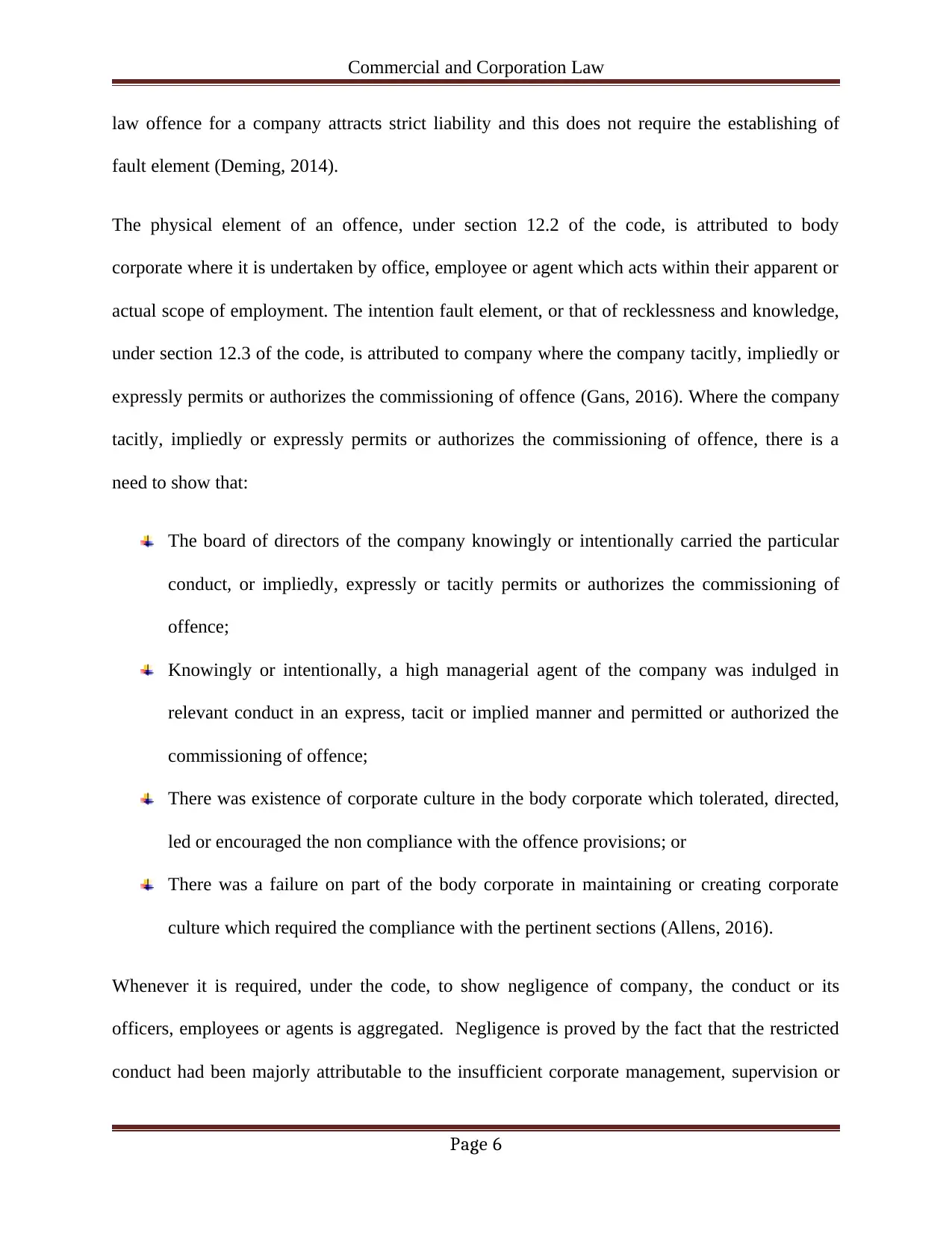
Commercial and Corporation Law
law offence for a company attracts strict liability and this does not require the establishing of
fault element (Deming, 2014).
The physical element of an offence, under section 12.2 of the code, is attributed to body
corporate where it is undertaken by office, employee or agent which acts within their apparent or
actual scope of employment. The intention fault element, or that of recklessness and knowledge,
under section 12.3 of the code, is attributed to company where the company tacitly, impliedly or
expressly permits or authorizes the commissioning of offence (Gans, 2016). Where the company
tacitly, impliedly or expressly permits or authorizes the commissioning of offence, there is a
need to show that:
The board of directors of the company knowingly or intentionally carried the particular
conduct, or impliedly, expressly or tacitly permits or authorizes the commissioning of
offence;
Knowingly or intentionally, a high managerial agent of the company was indulged in
relevant conduct in an express, tacit or implied manner and permitted or authorized the
commissioning of offence;
There was existence of corporate culture in the body corporate which tolerated, directed,
led or encouraged the non compliance with the offence provisions; or
There was a failure on part of the body corporate in maintaining or creating corporate
culture which required the compliance with the pertinent sections (Allens, 2016).
Whenever it is required, under the code, to show negligence of company, the conduct or its
officers, employees or agents is aggregated. Negligence is proved by the fact that the restricted
conduct had been majorly attributable to the insufficient corporate management, supervision or
Page 6
law offence for a company attracts strict liability and this does not require the establishing of
fault element (Deming, 2014).
The physical element of an offence, under section 12.2 of the code, is attributed to body
corporate where it is undertaken by office, employee or agent which acts within their apparent or
actual scope of employment. The intention fault element, or that of recklessness and knowledge,
under section 12.3 of the code, is attributed to company where the company tacitly, impliedly or
expressly permits or authorizes the commissioning of offence (Gans, 2016). Where the company
tacitly, impliedly or expressly permits or authorizes the commissioning of offence, there is a
need to show that:
The board of directors of the company knowingly or intentionally carried the particular
conduct, or impliedly, expressly or tacitly permits or authorizes the commissioning of
offence;
Knowingly or intentionally, a high managerial agent of the company was indulged in
relevant conduct in an express, tacit or implied manner and permitted or authorized the
commissioning of offence;
There was existence of corporate culture in the body corporate which tolerated, directed,
led or encouraged the non compliance with the offence provisions; or
There was a failure on part of the body corporate in maintaining or creating corporate
culture which required the compliance with the pertinent sections (Allens, 2016).
Whenever it is required, under the code, to show negligence of company, the conduct or its
officers, employees or agents is aggregated. Negligence is proved by the fact that the restricted
conduct had been majorly attributable to the insufficient corporate management, supervision or
Page 6
⊘ This is a preview!⊘
Do you want full access?
Subscribe today to unlock all pages.

Trusted by 1+ million students worldwide
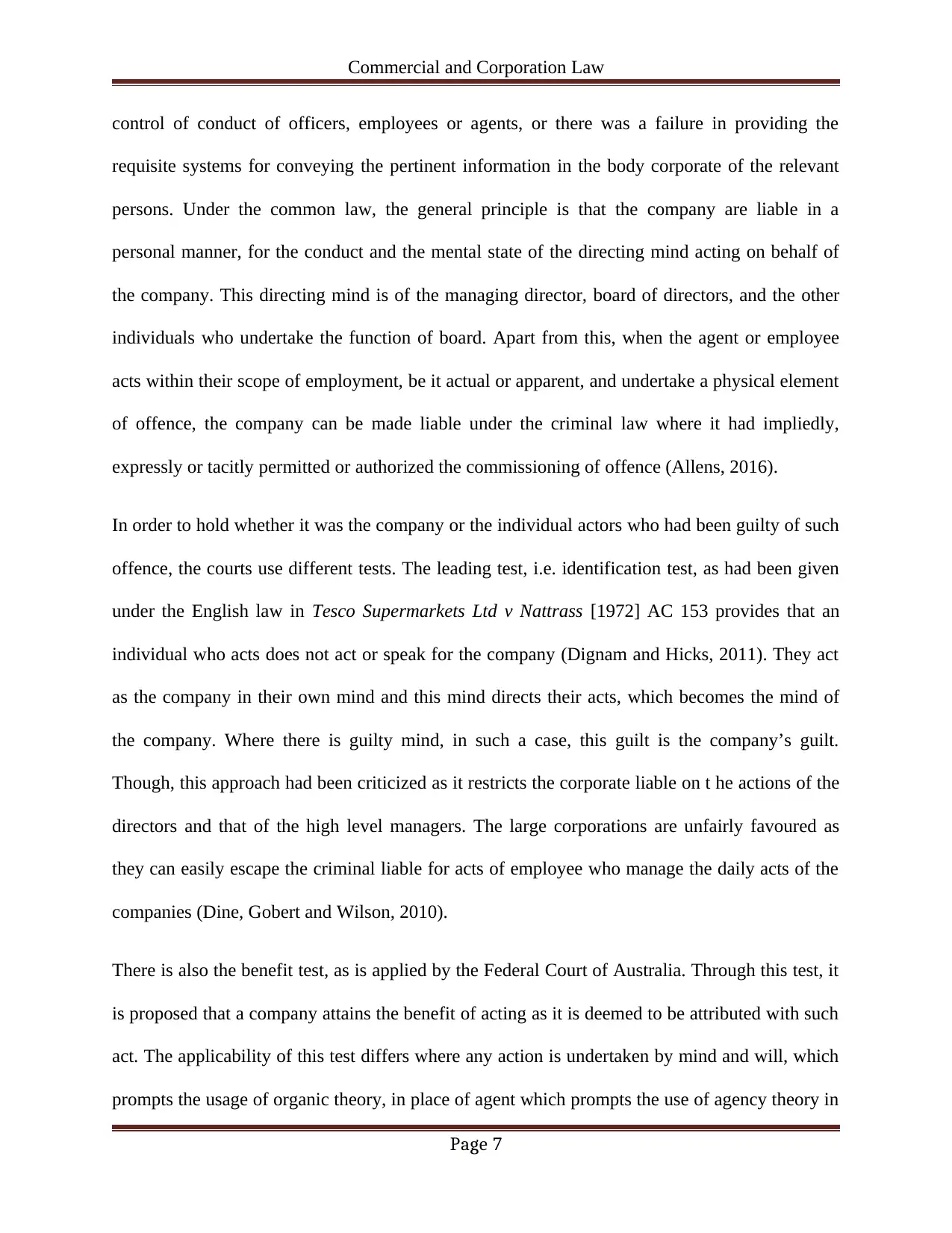
Commercial and Corporation Law
control of conduct of officers, employees or agents, or there was a failure in providing the
requisite systems for conveying the pertinent information in the body corporate of the relevant
persons. Under the common law, the general principle is that the company are liable in a
personal manner, for the conduct and the mental state of the directing mind acting on behalf of
the company. This directing mind is of the managing director, board of directors, and the other
individuals who undertake the function of board. Apart from this, when the agent or employee
acts within their scope of employment, be it actual or apparent, and undertake a physical element
of offence, the company can be made liable under the criminal law where it had impliedly,
expressly or tacitly permitted or authorized the commissioning of offence (Allens, 2016).
In order to hold whether it was the company or the individual actors who had been guilty of such
offence, the courts use different tests. The leading test, i.e. identification test, as had been given
under the English law in Tesco Supermarkets Ltd v Nattrass [1972] AC 153 provides that an
individual who acts does not act or speak for the company (Dignam and Hicks, 2011). They act
as the company in their own mind and this mind directs their acts, which becomes the mind of
the company. Where there is guilty mind, in such a case, this guilt is the company’s guilt.
Though, this approach had been criticized as it restricts the corporate liable on t he actions of the
directors and that of the high level managers. The large corporations are unfairly favoured as
they can easily escape the criminal liable for acts of employee who manage the daily acts of the
companies (Dine, Gobert and Wilson, 2010).
There is also the benefit test, as is applied by the Federal Court of Australia. Through this test, it
is proposed that a company attains the benefit of acting as it is deemed to be attributed with such
act. The applicability of this test differs where any action is undertaken by mind and will, which
prompts the usage of organic theory, in place of agent which prompts the use of agency theory in
Page 7
control of conduct of officers, employees or agents, or there was a failure in providing the
requisite systems for conveying the pertinent information in the body corporate of the relevant
persons. Under the common law, the general principle is that the company are liable in a
personal manner, for the conduct and the mental state of the directing mind acting on behalf of
the company. This directing mind is of the managing director, board of directors, and the other
individuals who undertake the function of board. Apart from this, when the agent or employee
acts within their scope of employment, be it actual or apparent, and undertake a physical element
of offence, the company can be made liable under the criminal law where it had impliedly,
expressly or tacitly permitted or authorized the commissioning of offence (Allens, 2016).
In order to hold whether it was the company or the individual actors who had been guilty of such
offence, the courts use different tests. The leading test, i.e. identification test, as had been given
under the English law in Tesco Supermarkets Ltd v Nattrass [1972] AC 153 provides that an
individual who acts does not act or speak for the company (Dignam and Hicks, 2011). They act
as the company in their own mind and this mind directs their acts, which becomes the mind of
the company. Where there is guilty mind, in such a case, this guilt is the company’s guilt.
Though, this approach had been criticized as it restricts the corporate liable on t he actions of the
directors and that of the high level managers. The large corporations are unfairly favoured as
they can easily escape the criminal liable for acts of employee who manage the daily acts of the
companies (Dine, Gobert and Wilson, 2010).
There is also the benefit test, as is applied by the Federal Court of Australia. Through this test, it
is proposed that a company attains the benefit of acting as it is deemed to be attributed with such
act. The applicability of this test differs where any action is undertaken by mind and will, which
prompts the usage of organic theory, in place of agent which prompts the use of agency theory in
Page 7
Paraphrase This Document
Need a fresh take? Get an instant paraphrase of this document with our AI Paraphraser
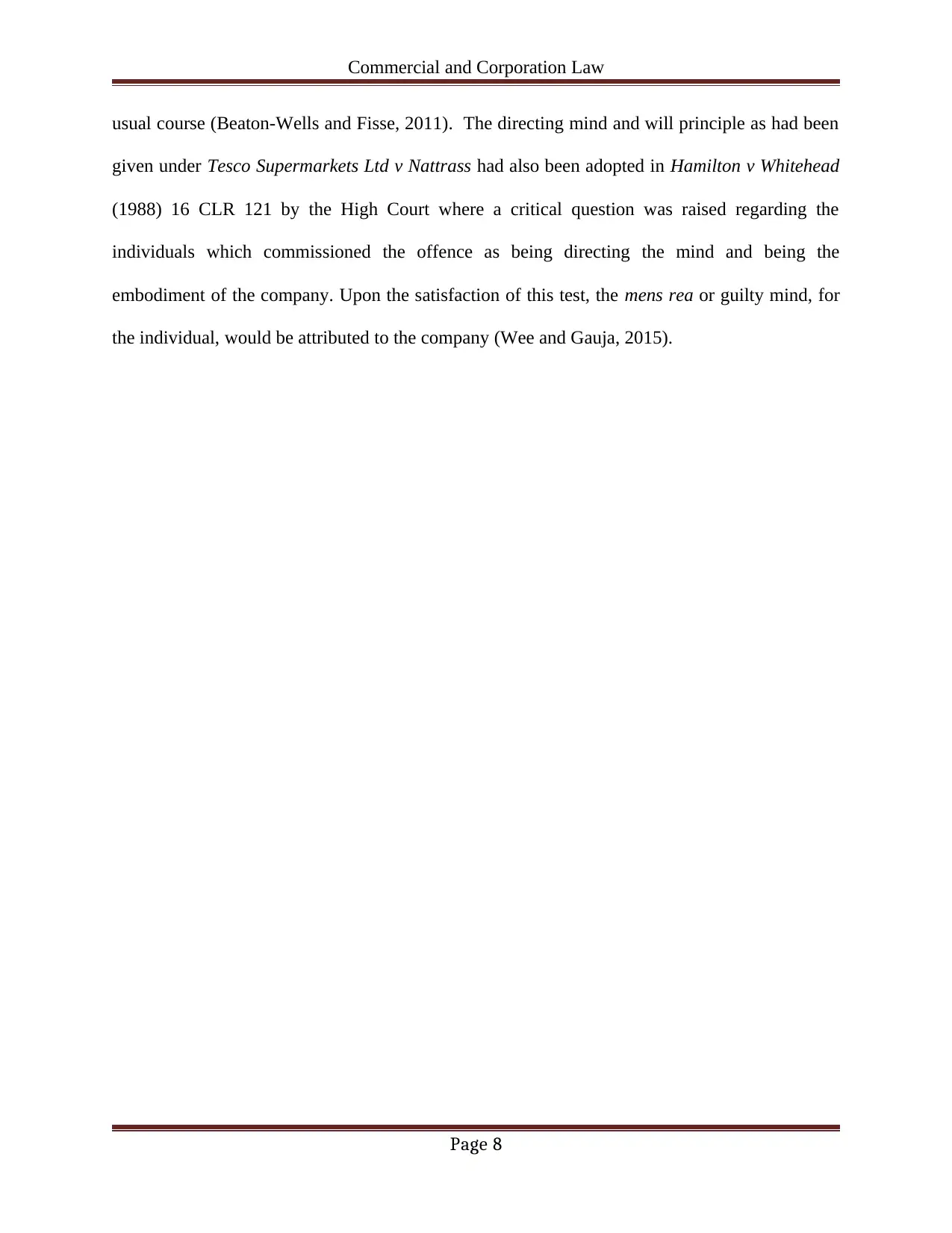
Commercial and Corporation Law
usual course (Beaton-Wells and Fisse, 2011). The directing mind and will principle as had been
given under Tesco Supermarkets Ltd v Nattrass had also been adopted in Hamilton v Whitehead
(1988) 16 CLR 121 by the High Court where a critical question was raised regarding the
individuals which commissioned the offence as being directing the mind and being the
embodiment of the company. Upon the satisfaction of this test, the mens rea or guilty mind, for
the individual, would be attributed to the company (Wee and Gauja, 2015).
Page 8
usual course (Beaton-Wells and Fisse, 2011). The directing mind and will principle as had been
given under Tesco Supermarkets Ltd v Nattrass had also been adopted in Hamilton v Whitehead
(1988) 16 CLR 121 by the High Court where a critical question was raised regarding the
individuals which commissioned the offence as being directing the mind and being the
embodiment of the company. Upon the satisfaction of this test, the mens rea or guilty mind, for
the individual, would be attributed to the company (Wee and Gauja, 2015).
Page 8
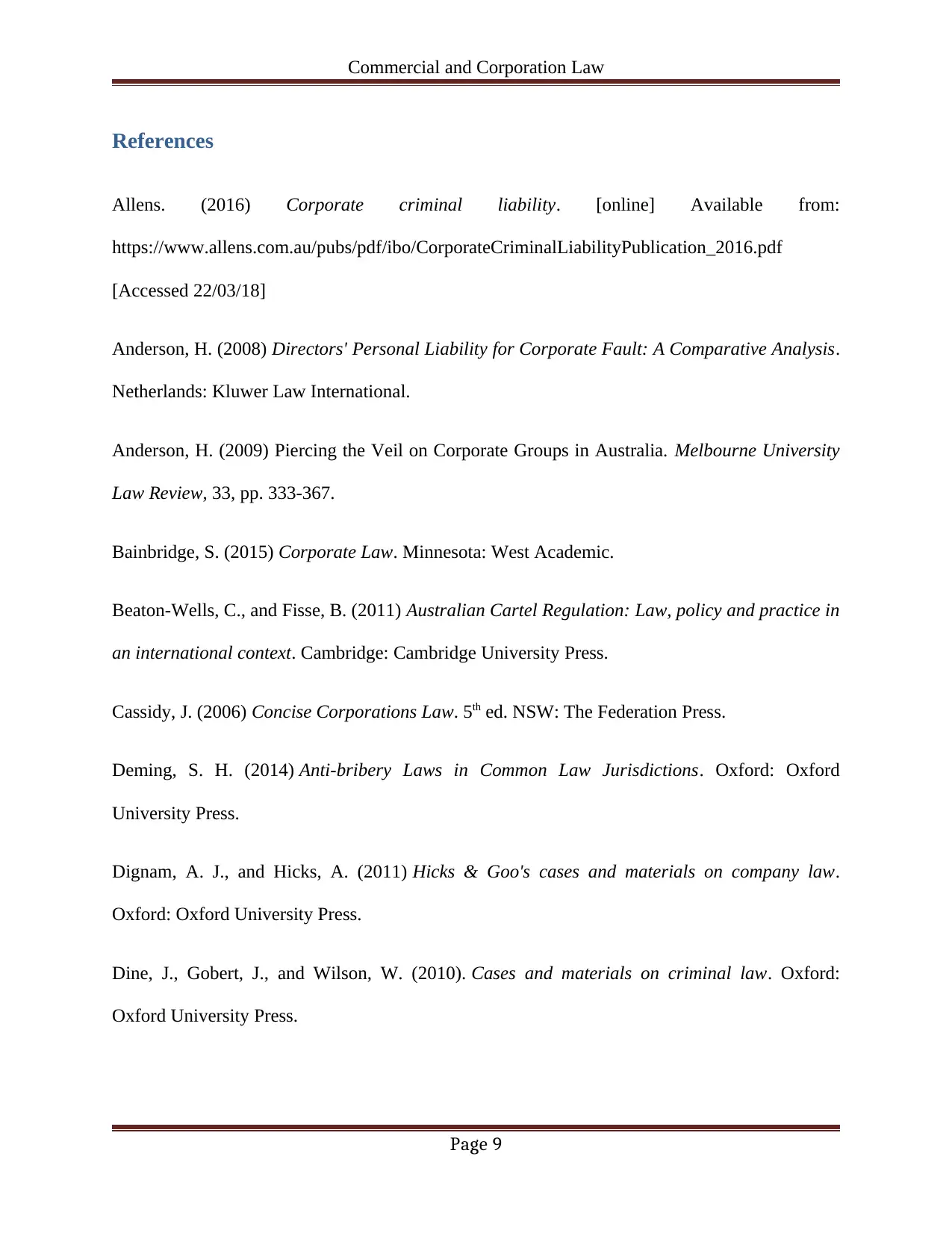
Commercial and Corporation Law
References
Allens. (2016) Corporate criminal liability. [online] Available from:
https://www.allens.com.au/pubs/pdf/ibo/CorporateCriminalLiabilityPublication_2016.pdf
[Accessed 22/03/18]
Anderson, H. (2008) Directors' Personal Liability for Corporate Fault: A Comparative Analysis.
Netherlands: Kluwer Law International.
Anderson, H. (2009) Piercing the Veil on Corporate Groups in Australia. Melbourne University
Law Review, 33, pp. 333-367.
Bainbridge, S. (2015) Corporate Law. Minnesota: West Academic.
Beaton-Wells, C., and Fisse, B. (2011) Australian Cartel Regulation: Law, policy and practice in
an international context. Cambridge: Cambridge University Press.
Cassidy, J. (2006) Concise Corporations Law. 5th ed. NSW: The Federation Press.
Deming, S. H. (2014) Anti-bribery Laws in Common Law Jurisdictions. Oxford: Oxford
University Press.
Dignam, A. J., and Hicks, A. (2011) Hicks & Goo's cases and materials on company law.
Oxford: Oxford University Press.
Dine, J., Gobert, J., and Wilson, W. (2010). Cases and materials on criminal law. Oxford:
Oxford University Press.
Page 9
References
Allens. (2016) Corporate criminal liability. [online] Available from:
https://www.allens.com.au/pubs/pdf/ibo/CorporateCriminalLiabilityPublication_2016.pdf
[Accessed 22/03/18]
Anderson, H. (2008) Directors' Personal Liability for Corporate Fault: A Comparative Analysis.
Netherlands: Kluwer Law International.
Anderson, H. (2009) Piercing the Veil on Corporate Groups in Australia. Melbourne University
Law Review, 33, pp. 333-367.
Bainbridge, S. (2015) Corporate Law. Minnesota: West Academic.
Beaton-Wells, C., and Fisse, B. (2011) Australian Cartel Regulation: Law, policy and practice in
an international context. Cambridge: Cambridge University Press.
Cassidy, J. (2006) Concise Corporations Law. 5th ed. NSW: The Federation Press.
Deming, S. H. (2014) Anti-bribery Laws in Common Law Jurisdictions. Oxford: Oxford
University Press.
Dignam, A. J., and Hicks, A. (2011) Hicks & Goo's cases and materials on company law.
Oxford: Oxford University Press.
Dine, J., Gobert, J., and Wilson, W. (2010). Cases and materials on criminal law. Oxford:
Oxford University Press.
Page 9
⊘ This is a preview!⊘
Do you want full access?
Subscribe today to unlock all pages.

Trusted by 1+ million students worldwide
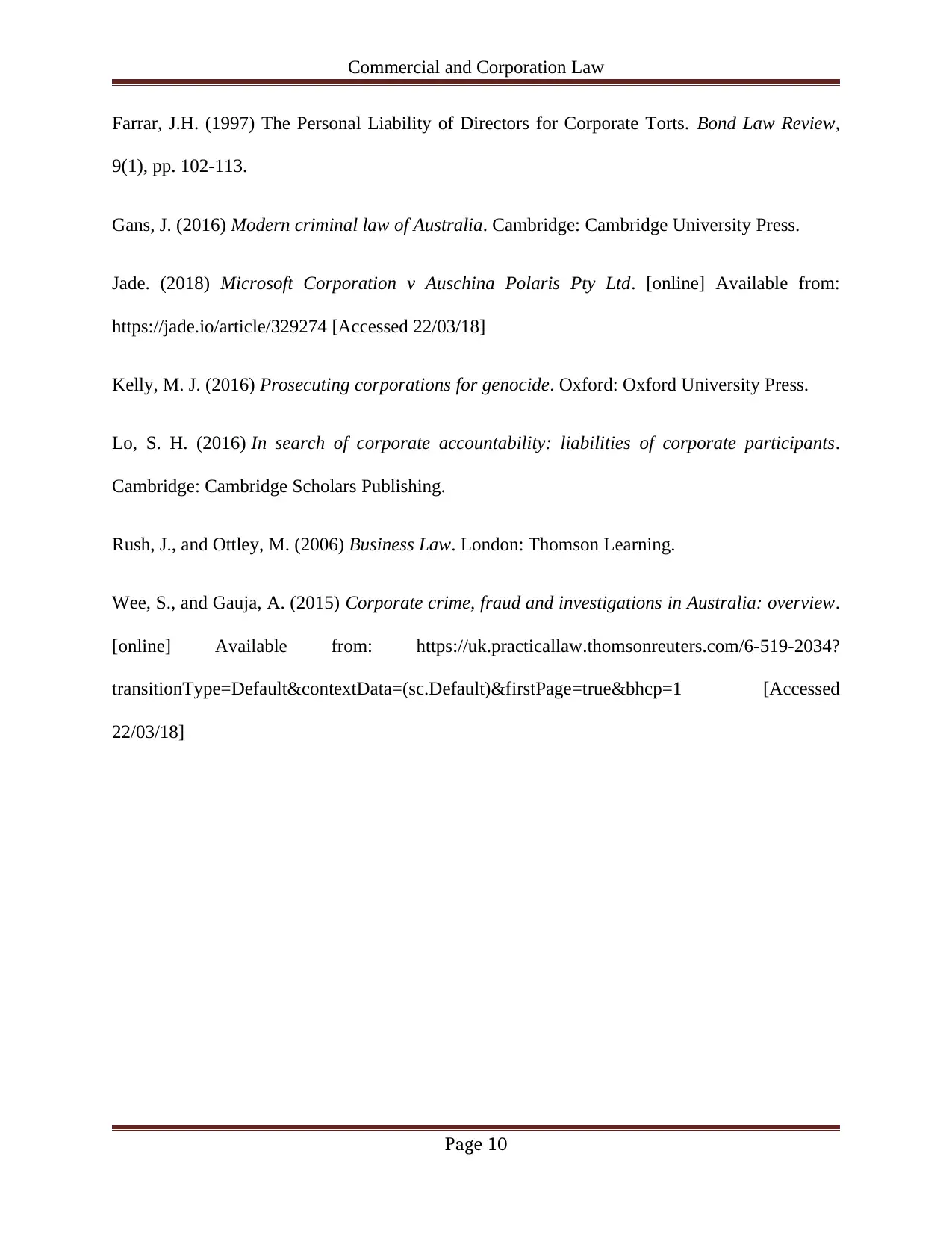
Commercial and Corporation Law
Farrar, J.H. (1997) The Personal Liability of Directors for Corporate Torts. Bond Law Review,
9(1), pp. 102-113.
Gans, J. (2016) Modern criminal law of Australia. Cambridge: Cambridge University Press.
Jade. (2018) Microsoft Corporation v Auschina Polaris Pty Ltd. [online] Available from:
https://jade.io/article/329274 [Accessed 22/03/18]
Kelly, M. J. (2016) Prosecuting corporations for genocide. Oxford: Oxford University Press.
Lo, S. H. (2016) In search of corporate accountability: liabilities of corporate participants.
Cambridge: Cambridge Scholars Publishing.
Rush, J., and Ottley, M. (2006) Business Law. London: Thomson Learning.
Wee, S., and Gauja, A. (2015) Corporate crime, fraud and investigations in Australia: overview.
[online] Available from: https://uk.practicallaw.thomsonreuters.com/6-519-2034?
transitionType=Default&contextData=(sc.Default)&firstPage=true&bhcp=1 [Accessed
22/03/18]
Page 10
Farrar, J.H. (1997) The Personal Liability of Directors for Corporate Torts. Bond Law Review,
9(1), pp. 102-113.
Gans, J. (2016) Modern criminal law of Australia. Cambridge: Cambridge University Press.
Jade. (2018) Microsoft Corporation v Auschina Polaris Pty Ltd. [online] Available from:
https://jade.io/article/329274 [Accessed 22/03/18]
Kelly, M. J. (2016) Prosecuting corporations for genocide. Oxford: Oxford University Press.
Lo, S. H. (2016) In search of corporate accountability: liabilities of corporate participants.
Cambridge: Cambridge Scholars Publishing.
Rush, J., and Ottley, M. (2006) Business Law. London: Thomson Learning.
Wee, S., and Gauja, A. (2015) Corporate crime, fraud and investigations in Australia: overview.
[online] Available from: https://uk.practicallaw.thomsonreuters.com/6-519-2034?
transitionType=Default&contextData=(sc.Default)&firstPage=true&bhcp=1 [Accessed
22/03/18]
Page 10
1 out of 10
Related Documents
Your All-in-One AI-Powered Toolkit for Academic Success.
+13062052269
info@desklib.com
Available 24*7 on WhatsApp / Email
![[object Object]](/_next/static/media/star-bottom.7253800d.svg)
Unlock your academic potential
Copyright © 2020–2025 A2Z Services. All Rights Reserved. Developed and managed by ZUCOL.





